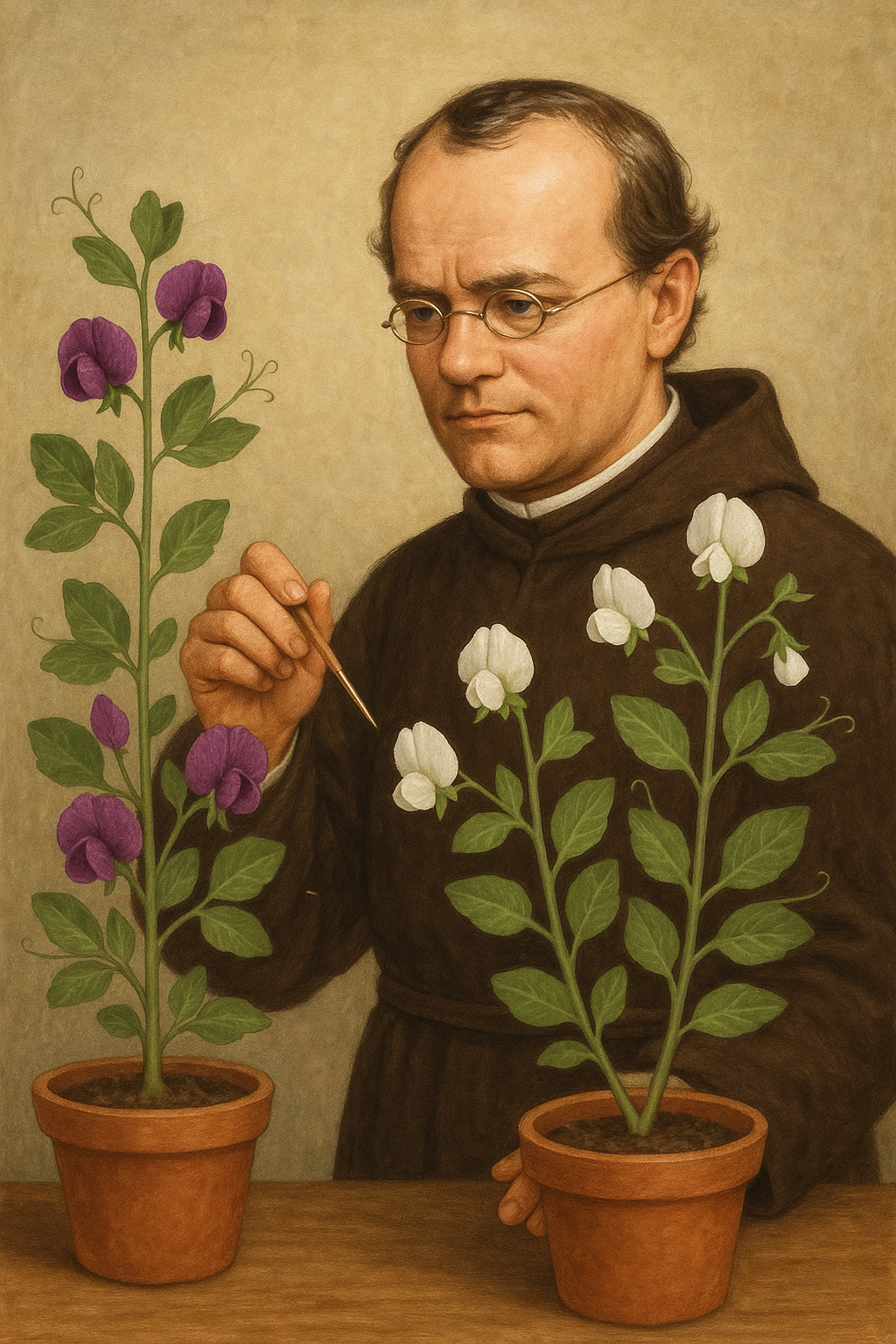Mendel's Garden
Genetics as a science is relatively new, but the concept of heredity has been known to humans for millennia. Our ancestors experimented with various plants and animals to breed specific varieties which they could domesticate. That is how wolves became various breeds of dogs, wild grains became cereals and aurochs became domestic cattle.
While it was common sense that offspring inherited traits from their parents, the mechanism behind this was not well understood until late 19th century.
Until one Austrian monk named Gregor Mendel revolutionized our understanding of life itself.

Mendel in his experimental garden
Where the laws of heredity were discovered
Before we begin, let's test your intuition
If a pure bred tall pea plant(one which comes from a lineage of tall plants) is crossed with a pure bred short pea plant, what would you expect the offspring to be?
Mendel's Revolutionary Approach
Gregor Mendel challenged the 'common sense' of his time in such a methodical way that his findings have stood the test of time, validated by subsequent discoveries like chromosomes and DNA.
Man of Faith & Science
A monk with access to a 2-acre garden that became his experimental laboratory, who also studied both physics and biology.
Statistical Pioneer
First to apply mathematical methods in biology, going against peers who believed math wasn't required in biological studies.
Scientific Method
His experiment remains one of the greatest examples of scientific method where he formulated hypotheses, conducted experiments, and analyzed data to draw conclusions about inheritance.
Interactive Experiments
Follow in Mendel's footsteps through this set of carefully designed experiments. Each builds upon the previous, taking you from basic inheritance to complex genetic analysis.

Seven Traits, Endless Discoveries
Flower color • Seed shape • Pod form • And more...
Section 1 of 8
The Story
Understand Mendel's scientific approach and the seven pea plant traits he chose for his groundbreaking experiments.
Your Discovery
Learn why pea plants were perfect for genetic studies and how Mendel ensured pure-breeding lines.
Skills You'll Master
Section 2 of 8
The Story
Begin where Mendel began—tracking a single trait through generations. Watch as purple and white flowers reveal the hidden laws of dominance and segregation.
Your Discovery
Discover why traits don't blend but remain discrete, and learn how to predict offspring ratios with mathematical precision.
Skills You'll Master
Section 3 of 8
The Story
Faced with plants showing dominant traits, Mendel wondered: are they purebred or hybrids? His solution was elegantly simple.
Your Discovery
Learn the test cross technique—still used by breeders and researchers to reveal hidden genotypes.
Skills You'll Master
Section 4 of 8
The Story
Mendel's persistence led him to continue experiments through F₃, F₄, and F₅ generations, revealing beautiful mathematical patterns.
Your Discovery
Observe how pure-breeding lines increase while heterozygotes remain constant, following predictable mathematical laws.
Skills You'll Master
Section 5 of 8
The Story
Mendel's breakthrough came when he tracked two traits simultaneously. Seed color AND shape—would they inherit together or separately?
Your Discovery
Uncover the Law of Independent Assortment through the famous 9:3:3:1 ratio that shocked the scientific world.
Skills You'll Master
Section 6 of 8
The Story
As experiments grew complex, Mendel needed new mathematical tools. How do you track three, four, or more traits without drowning in calculations?
Your Discovery
Master the forked-line method and probability mathematics that modern geneticists still use today.
Skills You'll Master
Section 7 of 8
The Story
From plants to people—explore how Mendel's laws apply to human families and reveal the inheritance patterns in our own lineages.
Your Discovery
Analyze family trees to track genetic diseases and understand how traits move through generations.
Skills You'll Master
Section 8 of 8
The Story
Extend beyond Mendel's simple dominance to explore co-dominance and sex-linked inheritance patterns in modern genetics.
Your Discovery
Understand how blood types work and why some genetic diseases affect males more than females.
Skills You'll Master
Mendel's Lasting Legacy
Laws Published
Initially ignored by the scientific community
Rediscovered
Three scientists independently confirmed his work
DNA Structure
Watson & Crick build on Mendel's foundation
Gene Therapy
Modern medicine relies on Mendelian principles
"A monk's curiosity about pea plants in a monastery garden ultimately unlocked the secrets of life itself."Today, every genetic counselor, plant breeder, and medical researcher uses principles that Mendel discovered over 150 years ago. His work forms the foundation of fields as diverse as personalized medicine, agricultural science, and evolutionary biology.
Ready to Begin Your Journey?
Each experiment builds upon the previous one, taking you from basic concepts to advanced genetic analysis. You'll work with the same seven traits Mendel studied, using modern interactive tools to uncover the same revolutionary insights.
